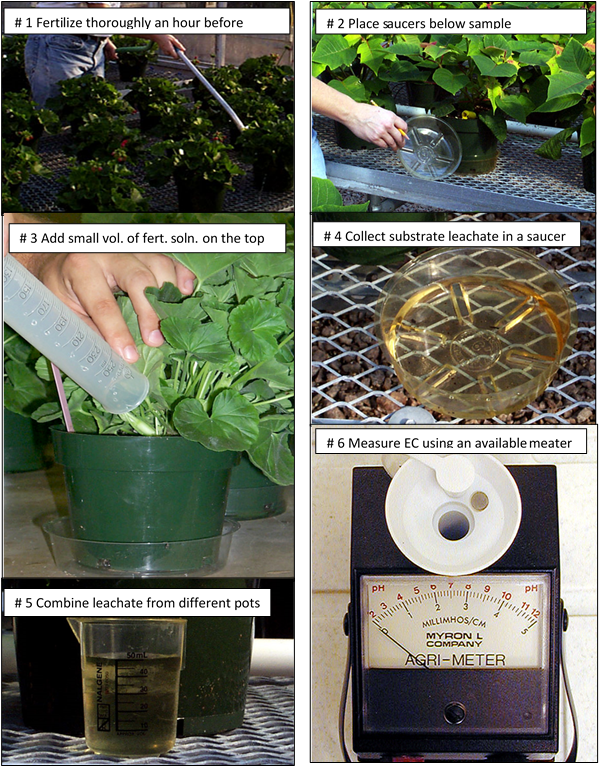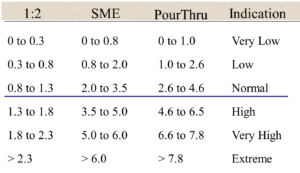Managing plant nutrition based on substrate EC is better than fertilizer solution EC as substrate EC directly measures the amount of nutrients in the root zone. There are both in-house and laboratory based methods of measuring substrate EC. One in-house method that is commonly used is ‘pour-thru’ technique. This technique is rapid, inexpensive and measures electrical conductivity of solution in the substrate pores (i.e., measures pore-water conductivity).
There are some important considerations to follow in order to get accurate results using ‘pour-thru’ technique. The correct procedure is described below :
- Step 1: ‘Fertigate’ plants to container capacity as usual (i.e., using the regular fertilizer solution) at least an hour before sampling. During this one hour, the fertilizer solution in the pores will come in equilibrium with root uptake.
- Step 2: Place a saucer below the containers that will be sampled. Sample plants with different fertilizer requirements separately. At least sample five pots or cell packs/1000 and mark them. Randomly select plants from interior of bench and account for different growth stages during sampling (establishment, active growth, and bloom).
- Step 3: Again apply regular fertilizer solution uniformly at the top. The goal is to collect the residual solution in the pores and not the freshly applied solution. If you apply too much fertilizer solution at the top, you will end up collecting a mixture of solution in the pores and the applied solution. As a guideline, you can apply 75 mL for a 4-inch container and 100 mL for a 6-inch container. I recommend applying the same fertilizer solution you normally use to grow plants and not pure water, as you do not want to dilute the nutrient concentration in the containers due to sampling.
- Step 4: Collect the leachate that drains out of the pores into saucers. When you apply a small volume of fertilizer solution to the substrate at container capacity (i.e., all pores are filled), the added solution will push the solution that is already in the pores downwards. This way, the solution that is in the pores is collected in the saucers while the applied solution refills the pores. By doing this, we are sampling the solution in substrate pores that was in equilibrium with roots. If you apply too much solution at the top, the solution applied at the top also starts to leach out of the containers and gets collected in the saucers. This will results in erroneous data.
- Step 5: Combine solution from different samples into a beaker. Make sure to keep leachate from different species and growth stages separately.
- Step 6: Use any available EC meter to measure the electrical conductivity of the collected leachate. Use the values in table 1 to identify if the fertilizer status is in the optimal range or compare with other laboratory-based methods like 1:2 dilution or Saturated Media Extract methods.
Figure 1. Step by step illustration of ‘Pour-thru’ procedure described in the text

Table 1. Comparison of Pour-thru technique with other laboratory-based methods of measuring electrical conductivity of the substrate
